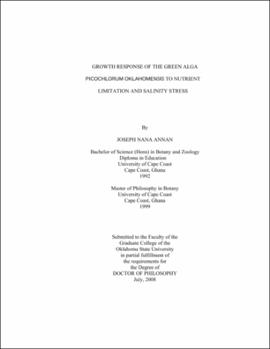| dc.contributor.advisor | Henley, William J. | |
| dc.contributor.author | Annan, Joseph Nana | |
| dc.date.accessioned | 2013-11-26T08:23:06Z | |
| dc.date.available | 2013-11-26T08:23:06Z | |
| dc.date.issued | 2008-07 | |
| dc.identifier.uri | https://hdl.handle.net/11244/6691 | |
| dc.description.abstract | Photosynthetic organisms rarely experience optimal growth conditions in their natural habitat, and at any given time, two or more physical and chemical variables are likely to be suboptimal. It has been previously established that the extreme environment of the Great Salt Plains (GSP) results in low algal biomass, such that natural selection is likely driven by survival of multiple abiotic stresses rather than rapid growth and biotic interactions. The purpose of this study is to determine the effect of combined abiotic stress factors on growth and photosynthesis in the green alga Picochlorum oklahomensis isolated from the GSP habitat, specifically salinity and the inorganic nutrients phosphorus (P), iron (Fe) and carbon (C). | |
| dc.description.abstract | Algal cells were grown in batch cultures under high or limited P, Fe and C at salinities of 10, 50 and 100 ppt in artificial seawater (AS 100) medium. Cells were physiologically characterized by initial growth rates and cell yields, photosynthetic light-response curves (oxygen evolution), pigment composition, and the chlorophyll fluorescence parameters Fv/Fm , (phi)PSII, qP and NPQ. | |
| dc.description.abstract | In general, low P and low Fe resulted in significant primary effects and interaction with salinity for the majority of variables; a significant primary effect of C and C-salinity interaction were less common among the physiological variables, probably because cultures are open to atmospheric CO2 but not to P or Fe. The chlorophyll fluorescence parameters Fv/Fm, (phi)PSII and NPQ all exhibit smaller responses to limitation by phosphorus or iron when grown at 100 ppt compared to 10 ppt. Similarly, with respect to pigment content and most fluorescence parameters, P. oklahomensis cultured in low P or Fe exhibit smaller inhibition by 100 ppt salinity relative to 10 ppt. Thus high salinity stress appears to be reduced under low nutrient conditions. P and Fe stress resulted in qualitative differences in physiological response. The overall P stress response indicates reversible photoprotection, whereas Fe stress response indicates chronic inhibition of PSII. | |
| dc.description.abstract | The interaction between salinity and P or Fe, together with previous reports of salinity-temperature interaction, are consistent with a general stress response that concurrently protects against several abiotic stress factors. | |
| dc.format | application/pdf | |
| dc.language | en_US | |
| dc.rights | Copyright is held by the author who has granted the Oklahoma State University Library the non-exclusive right to share this material in its institutional repository. Contact Digital Library Services at lib-dls@okstate.edu or 405-744-9161 for the permission policy on the use, reproduction or distribution of this material. | |
| dc.title | Growth response of the green alga Picochlorum oklahomensis to nutrient limitation and salinity stress | |
| dc.contributor.committeeMember | Burnap, Robert L. | |
| dc.contributor.committeeMember | Miller, Robert V. | |
| dc.contributor.committeeMember | Schonknecht, Gerald F. | |
| osu.filename | Annan_okstate_0664D_2774.pdf | |
| osu.accesstype | Open Access | |
| dc.type.genre | Dissertation | |
| dc.type.material | Text | |
| dc.subject.keywords | picochlorum | |
| dc.subject.keywords | salinity | |
| dc.subject.keywords | nutrient deficiency | |
| dc.subject.keywords | multiple stress tolerance | |
| dc.subject.keywords | chlorophyte | |
| thesis.degree.discipline | Plant Science | |
| thesis.degree.grantor | Oklahoma State University | |
